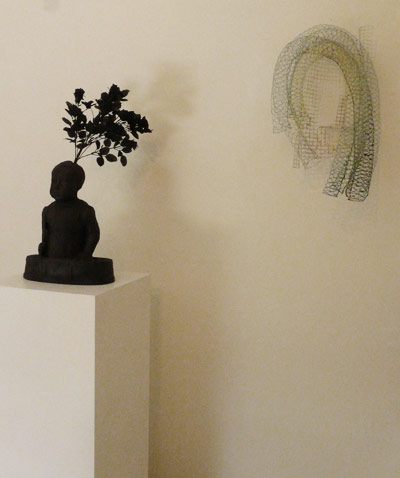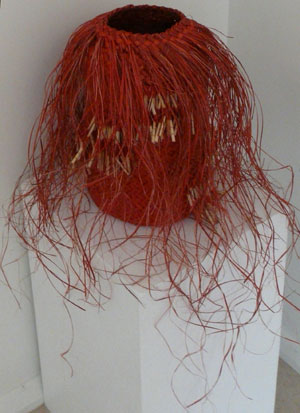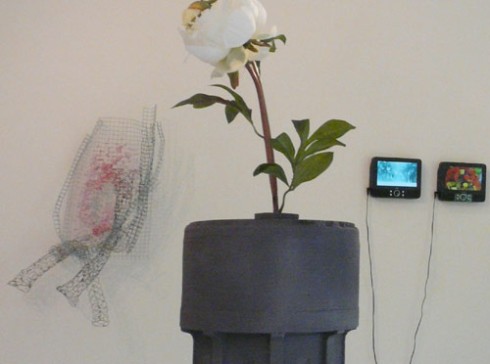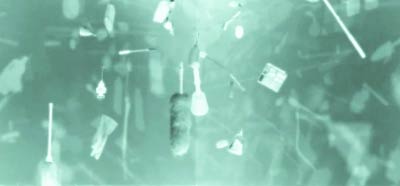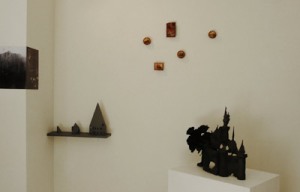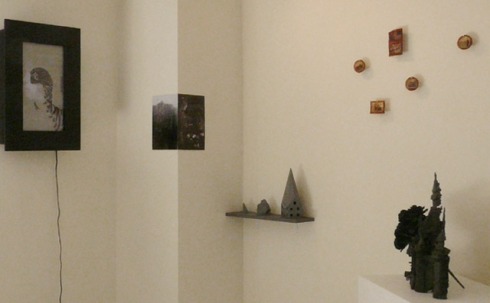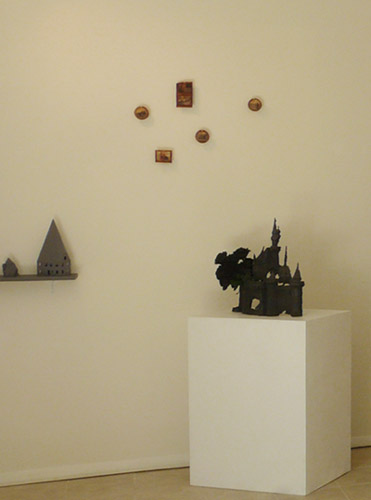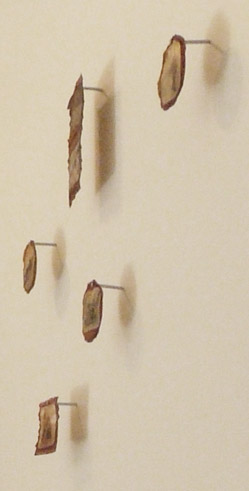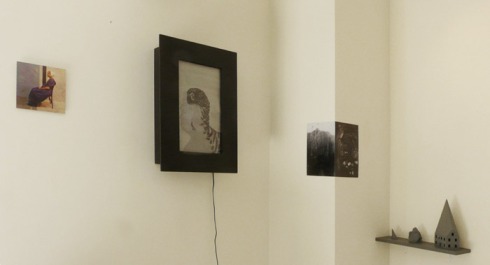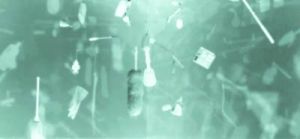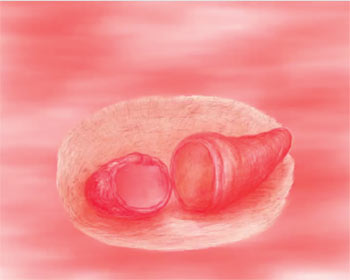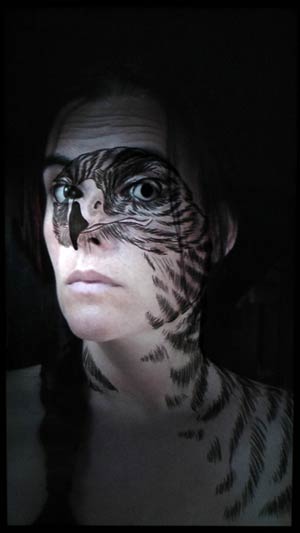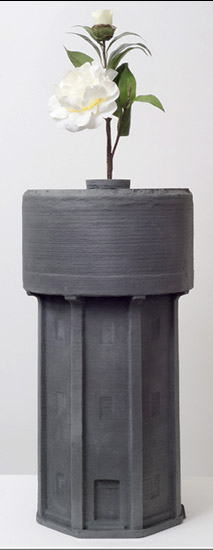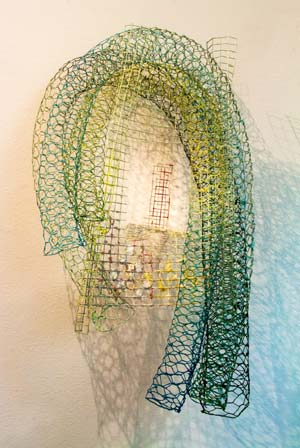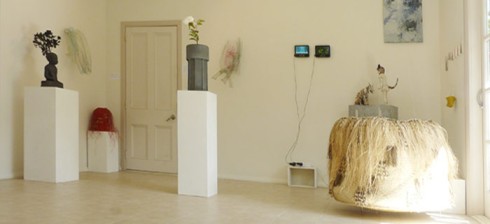
Left to Right: St Cyricus, plastic, artificial flowers and Epoxy, 40 x 15 x 60 cm by Brit Bunkley; Netting, wire and acrylic, by Michelle Backhouse; Pouhine (red basket form), harakeke (flax), muka (flax fibre), commercial dyes. Raranga + whatu (Māori weaving techniques) by Adrienne Spratt; Lake Alice Water-tower, plastic, paint and artificial flowers, 60 x 12 x 12 cm, by Brit Bunkley; Into the pink, wire and acrylic, by Michelle Backhouse; Cleaning the Air, 43 sec video + Daily Dishes, 7 min 11 sec video by Pietertje van Splunter; Oil on canvas by Edward Walton; From the War / No War series, six laser print on card reliefs (obliquely on the wall) by Hohepa; Kete Pingao, 20 x 10 cm, woven basket by Brenda Tuuta; Herenga rahi (Big connections/confinement), harakeke, muka, tanekaha bark and paru dyes. Raranga, whatu (Māori weaving techniques, suspended basket) by Adrienne Spratt.
Bunkley saw this statue in the Los Angeles Getty museum (view this statue) and was intrigued by the idea of a saint being a child. The story goes that in about 200-300 AD, that the child while being held by the governor (while the child’s mother, Saint Julitta, was on trial) the child stated that he was also a Christian and bit the governor. For this act of defiance the child was killed. Other stories tell of him being brutally tortured. The Renaissance artist incorporated symbols of sainthood such as the palm and laurel branches, and the cut off body suggests that he might be in a cauldron. The recasting of this in dark grey plastic with the addition of artificial flowers, makes the work an enigma because both aspects of social history (the religious and the art context of the statue at present) are simultaneously referenced and distanced.
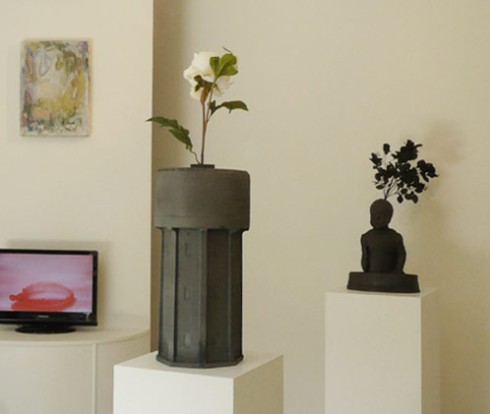
L to R: Een Rode Citroen (A red lemon), 2015, 9 min 53 sec., video + soundscape by Anne Wellmer; Oil on canvas by Edward Walton; Lake Alice Water-tower + St Cyricus by Brit Bunkley.
The flower could be a sign that nature always endures, always has some measure of self-sufficency, while the static cultural innate object gains or loses meaning if its function is lost. However in foregrounding the materiality of these sculptures, such as details in the greyer than grey facades, he reminds us that this is still artifice, it is still plastic, and in the end this is a sculpture of oppositions that forces us to take our own stance.
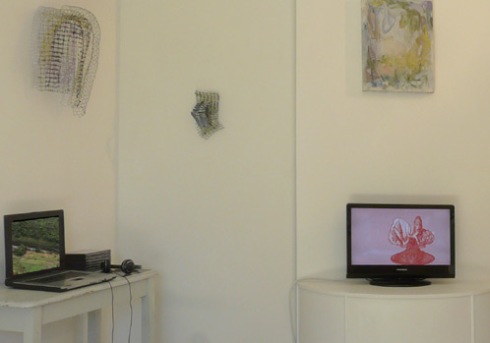
Left to Right: Kāinga a roto (Home Within), suite of 5 videos (on laptop) by Sonja van Kerkhoff, Adumbrate No. 2, 2014, wire netting + Untitled, 2017, wire netting and building paper by Michelle Backhouse; Oil on canvas by Edward Walton; Een Rode Citroen (A red lemon), 2015, animation, 9′ 53” by Anne Wellmer. Soundtrack: Anne Wellmer. Drawings: Geerten Ten Bosch. Animation: Harriët van Reek. Text excerpt from The Writing Notebooks (edited in English by Susan Sellers) by Hélène Cixous. Voice: Stephie Büttrich-Kolman.

Still from Vox Sanguinis (Voice of the blood), 1’53”. Video and soundtrack: Anne Wellmer. Video and soundtrack: Anne Wellmer. Camera: Florian Cramer. Voice: Cora Schmeiser. Music: “O rubor sanguinis” by Hildegard of Bingen. Trumpet: Heimo Wallner. Silent performer and stage design: Geerten Ten Bosch
Another video Vox Sanguinis (Voice of the blood), was a teaser for the music theater performance by Cora Schmeiser with new compositions inspired by Hildegard of Bingen (1098-1179) by 4 Dutch composers: Giuliano Bracci, Kate Moore, Lukas Simonis, Boudewijn Tarenskeen and Aliona Yurtsevich. The sound design and live electronics were by Anne Wellmer. Vox Sanguinis toured to four cities in the Netherlands in 2015.
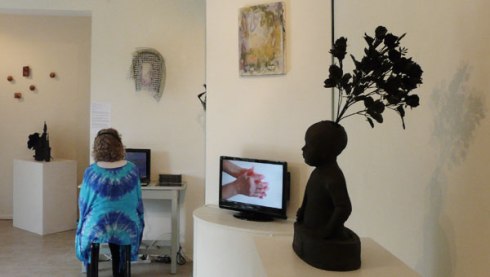
Left to Right: Warm Memories, emulsion on five suspended teabags by Martje Zandboer; The Happiest place on earth, plastic, paint and artifical flowers, 55 x 45 x 10 cm, by Brit Bunkley; Kāinga a roto (Home Within), videos (on laptop) by Sonja van Kerkhoff; Adumbrate No. 2, 2014, wire netting + Untitled, 2017, wire netting and building paper by Michelle Backhouse; Oil on canvas by Edward Walton; Transfusionen (Transfusions), 2015, video with sound, 2′ 43” by Anne Wellmer. Sound: Anne Wellmer. Hands: Geerten Ten Bosch. Voice: Cora Schmeiser. Music fragment from BLAST (2015) by Lukas Simonis. Text fragment from ‘Della Religione Christiana’ by Marsilio Ficino (1433-1499), first published in Italian in 1568. This German translation was published in ‘Das Blut: Symbolik und Magie’ (Blood: Symbolism and Magic) (2004) by Piero Camporesi; St Cyricus 3D plastic print sculpture by Brit Bunkley.
The sounds from these three videos were the soundscape of this show unless one put on headphones to listen to two of the other videos in the exhibition. Under two spatial abstractions of wire by Michelle Backhouse was the suite of videos, Kāinga a roto (Home Within), by Sonja van Kerkhoff (More >>) and around the corner was the 29 minute video, Et in Arcadia Ego by Channa Boon.

Left to Right: Et in Arcadia Ego, 29 min video by Channa Boon; Love of the other, 10 cm diameter, print on aluminium by Sonja van Kerkhoff; Muka and taniko kete, harakeke muka, tanekaha bark + paru dyes. Whatu and taniko (Māori fibre and weaving techniques) by Adrienne Spratt; What kind of Idea, print on dubond by Sonja van Kerkhoff (More >>).
Virgil’s phrase ‘Et in Arcadia Ego’ is also the title of a famous painting (1638) by Nicolas Poussin. The painting shows a group of shepherds who discover the phrase on a tomb, and so become aware of the existence of death in their Arcadian existence. This gives them the capacity to reflect and thus develop self-awareness. In this video, Boon connects this loss of innocence of the Arcadian shepherd – signifying an ideal world that is destroyed forever – with the present and past of the former Soviet Union. Hence, the phrase becomes a reference to the ideal world that Communism aimed to bring about in this region and the nostalgia that it still invokes.
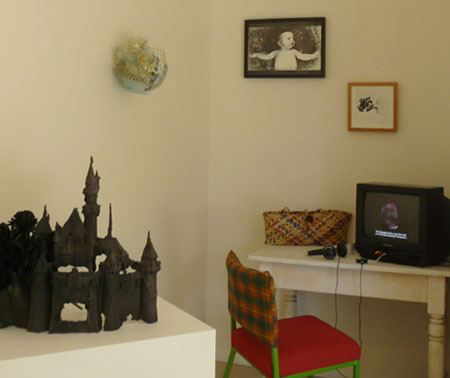
Left to Right: The Happiest place on earth, plastic, paint and artifical flowers by Brit Bunkley; Enclosure No. 1 wire netting + paperpulp by Michelle Backhouse; The Image (The spectacle is mesmeric in order to be successful), silkscreen print and mixed media (More >>) + Where change is barely visible, 2008, laser print by Sonja van Kerkhoff; Kete Whakairo (on table), dyed flax basket by Brenda Tuuta; Et in Arcadia Ego, 29 min video by Channa Boon.
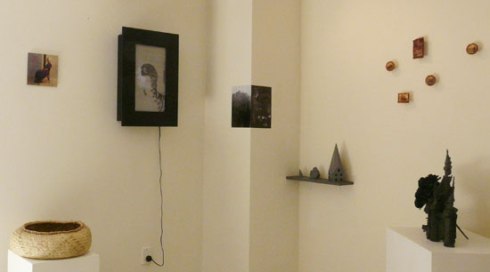
Left to Right: Mauri, harakeke, raranga (Māori weaving techniques) by Adrienne Spratt; Josephine’s Mother, print on aluminium, acrylic and varnish by Sonja van Kerkhoff (More >>); Bird of Prey, mixed media video loop by Sanne Maes; Untitled + Dark Entries, black and white photographs + The Speed of Dark, models on a shelf by Thom Vink; Warm Memories, photographic emulsion on teabags + magnets by Martje Zandboer and The Happiest place on earth, plastic, paint and artifical flowers, 55 x 45 x 10 cm, by Brit Bunkley (More >>).
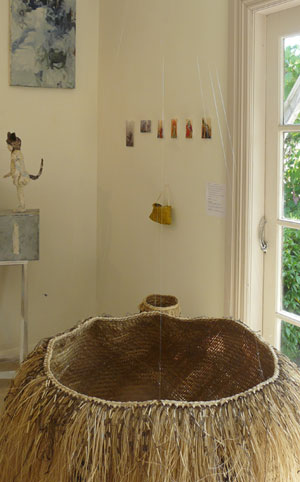
Left to Right: detail of Girl with Iberian Lynx by Michelle Backhouse; Oil on canvas by Edward Walton; From the War / No War series, six laser print on card reliefs, each is 10 x 15 x 2 cm, by Hohepa; Poutama (Step pattern), cylinder shaped basket + Herenga rahi (Big connections/confinement), harakeke, muka, tanekaha bark and paru dyes. Raranga, whatu (Māori weaving techniques) by Adrienne Spratt.
On the other side of the gallery space are two more woven vessels by Adrienne Spratt. The enormous basket sways from numerous lines. Its title refers to both connection and enclosure.
On the adjacent wall a frieze relief of reproductions of paintings from Hohepa’s War / No War series uses Maori cultural symbols as commentary issues of the day. Below this is a small purse-like open pingao (a New Zealand natuve yellow grass) basket by Brenda Tuuta.
In another corner lines flow out from the red basket, Pouhine by Adrienne Spratt, which blur its contours. The title refers to the pattern woven into the sides.
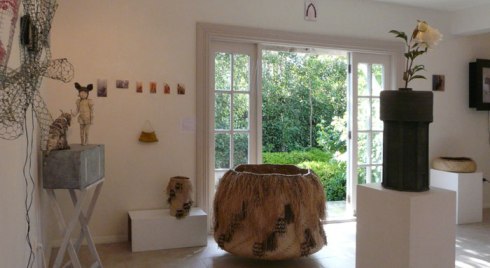
Left ot Right: Detail of Into the Pink, wire and paper pulp + Girl with Iberian Lynx by Michelle Backhouse; From the War / No War series, six laser print on card reliefs, each is 10 x 15 cm, by Hohepa; Kete Pingao, 20 x 10 cm, woven basket by Brenda Tuuta; Poutama (Step pattern), cylinder shaped basket + Herenga rahi (Big connections/confinement), harakeke, muka, tanekaha bark and paru dyes. Raranga, whatu (Māori weaving techniques) by Adrienne Spratt, Paewae (Threshold), aluminium print (above doorway) by Sonja van Kerkhoff; Lake Alice Water-tower, plastic sculpture by Brit Bunkley; Josephine’s Mother, print on aluminium, acrylic and varnish by Sonja van Kerkhoff; Mauri (essence/spirit), harakeke, raranga (Māori weaving techniques) by Adrienne Spratt; Detail of Bird of Prey, mixed media video loop by Sanne Maes.
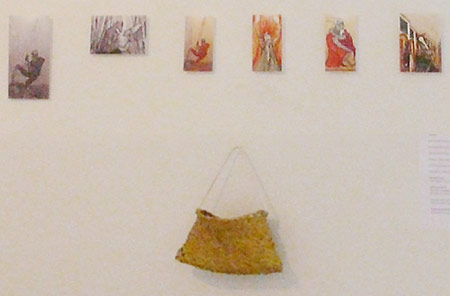
Left to Right: From the War / No War series: Warrior with Taiaha, Patu-paiarehe lovers, black and white laser prints on card, Warrior with Taiaha, Mākutu, No more war with Taiaha laid down, Rangatahi, colour laser prints on card, each piece approx. 10 x 15 x 2 cm, by Hohepa; Kete Pingao, 20 x 10 cm, woven basket by Brenda Tuuta.
The video Cleaning the Air is actually a recording of a mobile sculpture which animates various household cleaning objects while in the video, Daily Dishes, the mundane chore of doing the dishes is turned into an animation of colour and pattern. Pietertje van Splunter’s videos are like a poetics on the mundane: housework. Her brooms seem animated by an unearthly force and the constant stacking of the differing tribes of kitchen utensils suggests a game with secret rules. In using humour with the overkill her videos are reminders that the everyday domestic, is also a microcosm of the amusing, perhaps necessary banality of habit while Michelle Backhouse’s sculptures use seemingly banal materials, building paper, netting or house paint to create ethereal protusions.

